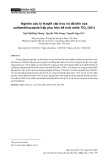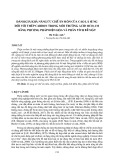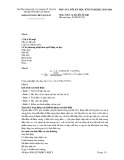
Bui Kieu My / Tạp chí Khoa học và Công nghệ Đại học Duy Tân 04(65) (2024) 176-181
176
Incorporation of Nitrogen-related species on Ga-rich GaN (0001)
surfaces
Cơ chế hấp thụ của các hợp chất Nitơ trên bề mặt giàu Ga của GaN (0001)
Bui Kieu Mya,b*
Bùi Kiều Mya,b*
aInstitute of Research and Development, Duy Tan University, Da Nang, 550000, Vietnam
aViện Nghiên cứu và Phát triển Công nghệ cao, Trường Đại học Duy Tân, Đà Nẵng, Việt Nam
bFaculty of Environment and Natural Sciences, Duy Tan University, Da Nang, 550000, Vietnam
bKhoa Môi trường và Khoa học Tự nhiên, Trường Công nghệ, Trường Đại học Duy Tân, Đà Nẵng, Việt Nam
(Date of receiving article: 27/03/2024, date of completion of review: 23/04/2024, date of acceptance for posting:
25/06/2024)
Abstract
We present features in the incorporation of Nitrogen-related species on the Ga-rich GaN (0001) surface based on first-
principles total energy calculations. We find that the N adatom spontaneously substitutes for the Ga adatom upon
adsorption and forms 4-fold N structure. Surprisingly, this substitutional adsorption does not have any activation energy.
Also, we find that NH2 and NH units intervene in the Ga-Ga weak bonds and form - Ga - (NHx) - Ga - structure during
the adsorption. This finding gives an insight into the fate of ammonia species during adsorption on the Ga-rich GaN
(0001) surface.
Keywords: Gallium Nitride; epitaxial growth; first principle simulation.
Tóm tắt
Chúng tôi trình bày cơ chế hấp thụ các hợp chất Nitơ trên bề mặt giàu Ga của GaN (0001) dựa trên các tính toán năng
lượng toàn phần theo nguyên lý đầu tiên. Chúng tôi thấy rằng nguyên tử Nitơ dễ dàng thay thế nguyên tử Ga khi hấp thụ
và tạo thành cấu trúc Nitơ bậc bốn. Điều ngạc nhiên là sự hấp thụ này không cần vượt qua bất kỳ hàng rào năng lượng
kích hoạt nào. Ngoài ra, chúng tôi nhận thấy NH2 và NH còn tham gia vào liên kết yếu Ga-Ga và hình thành cấu trúc -
Ga - (NHx) - Ga - trong quá trình hấp thụ. Phát hiện này mang lại cái nhìn tổng quan và sâu sắc về số phận của các hợp
chất Nitơ trong quá trình hấp thụ trên bề mặt giàu Ga của GaN (0001).
Từ khóa: Gallium Nitride; trồng xếp lớp epitaxy; mô phỏng nguyên lý đầu tiên.
1. Introduction
Nitride (III-V) semiconductor materials,
which include aluminum nitride (AlN), gallium
nitride (GaN), and indium nitride (InN), are
*Corresponding author: Bui Kieu My
Email: buitkieumy1@duytan.edu.vn
changing our lives significantly with two main
applications in optoelectronic devices and power
devices [1–3]. These materials, known for
having a wide band gap, have the power to pay
04(65) (2024) 176-181
DTU Journal of Science and Technology
D U Y T A N U N I V E R S I T Y
TẠP CHÍ KHOA HỌC VÀ CÔNG NGHÊ ĐẠI HỌC DUY TÂN

Bui Kieu My / Tạp chí Khoa học và Công nghệ Đại học Duy Tân 04(65) (2024) 176-181
177
less (less electricity, less waste heat) but gain
more (more light, more power). Among that,
GaN is becoming a promising material for the
next generation of light-emitting diodes (LEDs),
high-power and energy saving devices [4–9].
For the massive production of GaN, it is highly
demanding to fabricate a high-quality GaN. For
the fabrication of optoelectronic devices, the
(0001) surface of GaN is often used [10–12].
Metalorganic vapor phase epitaxy (MOVPE)
is known to massively produce the best quality
GaN crystals [1,2,13]. In MOVPE,
trimethylgallium (TMG) and ammonia are
generally used as source gases which are carried
to the growth section by a carrier gas, H2 or N2.
Kusaba et al. [8] reported that for the N2 carrier
gas, the Ga adatom surface was observed at low
temperatures. More recently, theoretical studies
show that the T4 site is the most favorable
adsorption site of the Ga adatom [15–18]. As
seen in Fig. 1a which presents adsorption sites
on the GaN (0001) bare surface, four high
symmetry sites for the surface adsorption are
addressed: T1 (on-top), BR (bridge), T4 (hcp),
and H3 (fcc) sites. Fig. 1b from Bui et al. [19]
shows the 2×2 Ga adatom surface at the T4 site.
It is seen that, the Ga adatom and three Ga atoms
at the topmost layer on the surface form Ga-Ga
weak bonds with smaller equivalue surface.
These weak bonds can be a candidate for the N
incorporation. Hereafter, the Ga adatom at the
T4 site can be considered as a representative of
the Ga-rich GaN (0001) surface.
Recently, Nagamatsu et al. [20] reported that
ammonia is rarely decomposed in the gas phase
using the high-resolution time-of-flight (TOF)
measurements. Or in another word, NH3 reaches
the surface. Also, a small amount (0.1%) of NH2
indeed exists on the surface. After approaching
the surface, some reaction occurs and results in
the product of NH2, NH, and N species. Thus, it
is important to identify the typical forms of the
nitrogen-related species on the Ga-rich GaN
(0001) and then examine what the fates of these
species are on the Ga-rich surface.
In this article, we present the incorporation of
nitrogen-related species on the Ga-rich GaN
(0001) surfaces based on first-principles total
energy calculations. We study how NHx (x = 0-
2) species adsorb on the surface and incorporate
in the Ga-Ga weak bond. The rest of this article
is organized as follows: In section II, we
describe the methodology used; In section III,
we show the characteristic of NHx (x = 0-2)
adsorption on various adsorption sites on the Ga
rich GaN (0001) surface; Section IV summaries
our works.
2. Methodology
Here, first principle total energy calculation is
performed in density functional theory (DFT)
[21,22], as implemented in our real space
density functional theory (RSDFT)
package [23,24]. Exchange-correlation energy
was treated by the Perdew-Burke-Ernzerhof
(PBE) [25] exchange-correlation functional
using the norm-conserving pseudo-potentials
where the Ga 3d electrons are treated as core
electrons [26]. In order to examine the
adsorption on the surface, we first optimized the
structure of the bulk GaN. The obtained lattice
parameters are in agreement with experiment (a
= 3.20 Å and c = 5.20 Å) [27]. We then built a
periodic slab of six double layers of GaN and a
(2×2) supercell. In order to avoid any interaction
between surface and its periodically repeated
images, we added 15 Å of vacuum region
between slabs. During the optimization, a 3×3×1
k-point is used. The atoms in the bottom layer
were passivated with Pseudo-hydrogens of
charged 0.75e to mimic the semi-infinite GaN
substrate [28]. The top four double layers were
allowed to relax until the maximum force acting
on each atom becomes less than 25 meV/Å. The
cutoff energy of 73 Ry was used. The bottom

Bui Kieu My / Tạp chí Khoa học và Công nghệ Đại học Duy Tân 04(65) (2024) 176-181
178
two bilayers and pseudohydrogens were kept
fixed to mimic bulk-like behavior.
3. Results
In order to study the adsorption of NHx
species on the Ga-rich GaN (0001) surface, we
put them on high symmetry sites shown in Fig.
1a and examine their stability by calculating the
binding energy. The binding energy Ebind is
defined as:
𝐸𝑏𝑖𝑛𝑑 = −(𝐸𝑠𝑢𝑟−𝑎𝑑 − 𝐸𝑠𝑢𝑟𝑓 − 𝐸𝑎𝑑)
where 𝐸𝑠𝑢𝑟−𝑎𝑑, 𝐸𝑠𝑢𝑟𝑓, 𝑎𝑛𝑑 𝐸𝑎𝑑 are the total
energies of the GaN-rich GaN surface plus the
ad-species, the Ga-rich GaN surface, and the
adsorbed species in the gas phase, respectively.
We first examine the adsorption of one N
atom on the Ga-rich GaN (0001) surface. It is
found that the N atom binds stably at the H3 site
with the binding energy of 8.34 eV. Here, a
striking feature of the geometry is found: there
happens substitutional adsorption in which the N
atom flips and makes bond with topmost Ga
atoms on the surface (bond length: 2.12 Å), and
the Ga adatom is in turn bonded with thus
incorporated N atom (bond length: 1.89 Å) as
depicted in Fig. 2b. The N adatom and topmost
Ga atoms form strong covalent bonds and are
therefore stabilized.
(a) (b)
Figure 1. a) Top view of the GaN (0001) surface and adsorption sites: T1, T4, H3, and BR (see text). Green (large)
and blue (small) balls depict the Ga and N atoms, respectively. b) Electron density for the Ga adatom at the T4 site.
Figure 2. Total energy as a function of N-surface distance d1 (Å). a) Optimized structure of the N atom at d1 = 4.7 Å, b)
Optimized structure of the N atom at d1 = 1.4 Å. Color code is the same as Fig. 1 with the Ga adatom shown in pink.

Bui Kieu My / Tạp chí Khoa học và Công nghệ Đại học Duy Tân 04(65) (2024) 176-181
179
In order to obtain activation energies for such
substitutional adsorption, we have performed the
total energy calculation for fixed vertical
distances, d1, between the N atom and the
surface. Fig. 2 shows the total energy as a
function of the N-surface distance d1. The
energy keeps decreasing as the N atom comes
closer to the surface when d1 > 1.4 Å. If the N
atom comes too close to the surface (d1 < 1.4 Å),
a repulsion between the N atom and surface
leads to the energy increase. Surprisingly, the
energy barrier for such substitutional adsorption
is absent. In other words, the N atom
spontaneously substitutes for the Ga adatom
upon adsorption. Previous studies by Jeong and
Oshiyama. [29] also found the substitutional
adsorption with no activation energy for the
adsorption of Si adatom on hydrogenated Si
(100) surfaces. Such spontaneous substitutional
adsorption is caused by the small atomic radius
of the H atom and the strong covalency of group
IV atoms. For our case, the reason is that the N
adatom is attracted to the surface by Ga atoms
on the surface while there is repulsion between
the Ga adatom and the surrounding Ga atoms on
the surface. Also, since the bonds between the
Ga adatom and topmost Ga atoms are rather
weak, they are easy to cleave. As a result, there
is such substitutional adsorption on the Ga-rich
GaN (0001) surface. This substitutional
adsorption is an essential process for the crystal
growth since it helps to form a new basic unit
constituting the GaN film without overcoming
any energy barrier.
Figure 3. Total energy as a function of NH-surface distance d2 (Å). a) Optimized structure of NH at d2 = 4.7 Å, b)
Optimized structure of NH at d2 = 2.0 Å. Green (large) and blue (small) balls depict the Ga and N atoms, respectively.
The Ga adatom and the H atoms are shown in pink and salmon pink, respectively.
Figure 4. Total energy as a function of NH2-surface distance d3 (Å). a) Optimized structure of NH2 at d3 = 3.8 Å, b)
Optimized structure of NH2 at d3 = 3.5 Å, c) Optimized structure of NH2 at d3 = 1.7 Å. The color code is the same as in
Fig. 3.

Bui Kieu My / Tạp chí Khoa học và Công nghệ Đại học Duy Tân 04(65) (2024) 176-181
180
Next, we explore the stability of NH on the
Ga-rich GaN (0001) surface. T1 is found to be
the most stable configuration of NH, being
followed by BR, H3, and Tad site with the
binding energies of 6.36 eV, 6.19 eV, 5.14 eV,
and 3.45 eV, respectively. The Ga−N and N−H
bond lengths at the T1 site are 1.88 Å and 1.02
Å, respectively. The geometry of NH adsorption
at the T1 site is shown in Fig. 3b. Surprisingly,
NH intervenes in the Ga-Ga weak bond and
forms - Ga - (NH) - Ga – structure. Similar to the
N atom case, we have done the examination of
the total energy calculation for the fixed vertical
distance, d2, between NH and the surface. Fig. 3
shows that when d2 > 2 Å, the closer NH to the
surface, the smaller total energy is. Then, this N
atom incorporation is a barrierless process.
Interestingly, the feature of N atom
incorporation into the Ga-Ga weak bond also
works for NH2. Indeed, NH2 at the T1 site is found
to intervene in the Ga-Ga weak bond and form -
Ga - (NH2) - Ga – structure as shown in Fig. 4c.
The calculated binding energy at the T1, BR, and
Tad site are 3.96 eV, 3.25 eV, 3.07 eV,
respectively. For the T1 structure, the average
Ga−N and N−H bond lengths on the surface are
2.06 Å and 1.02 Å, respectively. The H−N−H
angle is calculated to be 105.6°. Fig. 4 shows the
total energy as a function of the NH2-surface
distance d3. While the adsorption of N and NH is
barrierless, that of NH2 has the energy barrier of
2.34 eV. Above 4.1 Å, NH2 is still far away and
does not make a bond with any atom, thus NH2-
surface at d3 = 4.1 Å has high energy. At 3.8 Å,
since the Ga adatom makes the bond with NH2 as
shown in Fig. 4a, energy suddenly drops there. At
3.5 Å, NH2 does not have a bond again with any
atom, thus energy suddenly jumps up again as
depicted in Fig. 4b. NH2 has to climb energy of
2.34 eV to go from 3.8 Å to 3.5 Å. After that,
energy keeps decreasing until NH2 feels the
repulsion from the surface at d3 = 1.7 Å.
4. Conclusions
Based on the density functional theory
(DFT), we have theoretically investigated the
spontaneous incorporation of nitrogen-related
species on the Ga-rich GaN (0001) surface. First,
the incorporation of NHx (x = 0-2) on the Ga-rich
GaN (0001) surface is clarified. To our surprise,
the N atom is found to spontaneously adsorb on
the surface and form 4-fold N configuration. NH
units are found to spontaneously intervene in the
Ga-Ga weak bonds on the Ga-rich GaN (0001)
surface and form - Ga - (NH) - Ga - structure.
NH2 is also found to intervene in the Ga-Ga
weak bonds but it needs to climb energy of 2.34
eV. These findings give an insight into the fate
of ammonia species during adsorption on the Ga
rich GaN (0001) surface.
Acknowledgments
This work was carried out during my
postdoctoral time at Institute of Materials and
Systems for Sustainability, Nagoya University,
Japan. I would like to acknowledge the sincere
support provided by Professor Atsushi
Oshiyama and Professor Kenji Shiraishi during
the research of this work.
References
[1] I. Akasaki. (2015). “Nobel Lecture: Fascinated
journeys into blue light”. Rev. Mod. Phys. (87), 1119.
[2] H. Amano. (2015). “Nobel Lecture: Growth of GaN
on sapphire via low-temperature deposited buffer
layer and realization of p -type GaN by Mg doping
followed by low-energy electron beam irradiation”.
Rev. Mod. Phys. (87), 1133.
[3] S. Nakamura. (2015). “Nobel Lecture: Background
story of the invention of efficient blue InGaN light
emitting diodes”. Rev. Mod. Phys. (87), 1139.
[4] R. P. Parikh and R. A. Adomaitis. (2006). “An
overview of gallium nitride growth chemistry and its
effect on reactor design: Application to a planetary
radial-flow CVD system”. J. Cryst. Growth (286),
259.
[5] D. Ehrentraut, E. Meissner, and M. Bockowski.
(2013). Technology of Gallium Nitride Crystal
Growth. Springer Berlin.










![Bài giảng Các hiện tượng bề mặt và sự hấp phụ - TS. Trần Phi Hoàng Yến [mới nhất]](https://cdn.tailieu.vn/images/document/thumbnail/2015/20151101/buocchanvva2/135x160/1521446333003.jpg)

![Tài liệu Vi sinh vật môi trường [Mới nhất]](https://cdn.tailieu.vn/images/document/thumbnail/2025/20251123/ngkimxuyen/135x160/21891763953413.jpg)
![Sổ tay truyền thông Phân loại chất thải rắn sinh hoạt trên địa bàn tỉnh Quảng Nam [Chuẩn nhất]](https://cdn.tailieu.vn/images/document/thumbnail/2025/20251114/kimphuong1001/135x160/1701763094001.jpg)


![Quản lý chất thải nguy hại: Sổ tay Môi trường [Chuẩn nhất]](https://cdn.tailieu.vn/images/document/thumbnail/2025/20251029/kimphuong1001/135x160/9011761720170.jpg)









